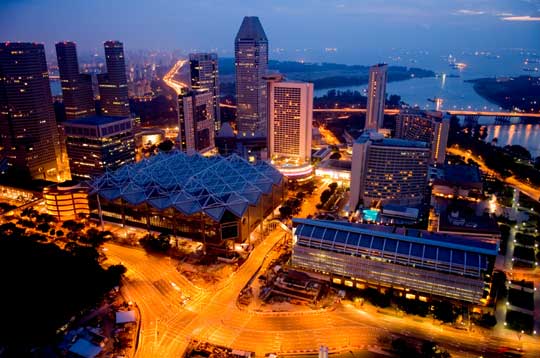Singapore's Domestic Press
 Singapore
Singapore
© Mark Tantrum, 2007
The Singapore government was unambivalent about the role of the domestic press in society: it should support, not criticize, government and elected leaders. This arrangement evolved over time. At its birth, Singapore had had a vibrant media scene, with many newspapers dating back to the 19th century. During the 1960s and 70s, however, Lee Kuan Yew and the PAP used various means to tame and co-opt the local press, ranging from intimidation to arrest and deportation. The government discredited uncooperative publications by, among other methods, claiming that Communist China sponsored them.
[12]
By June 2000, when the government announced that it would issue more media licenses and allow more domestic competition, the Singapore press had been brought fully under state control. [13] Singapore Press Holdings held a monopoly over print media, while MediaCorp controlled local broadcast outlets. Both were state companies; government figures—or people closely allied with the state—sat on their boards, and the government could veto any initiative.
The press, clarified Goh in his 1995 address to the Straits Times , had an obligation to provide “accurate reporting, clear analysis, and intelligent interpreting of events and developments through Singapore eyes for Singapore minds.” The task of the mass media was to create an atmosphere in which people were eager to acquire the “knowledge, skills and discipline of the advanced countries... and to avoid the wrong turns some of them have taken.” Singapore’s leaders, he noted, were elected; the press was self-appointed, and consequently had less legitimacy. He added:
The Western idea of the press as the fourth estate of the realm, as an adversarial watchdog of government, goes against our goal of consensus politics... Accurately reporting wrongdoings is a legitimate role... But the concept of the press being all powerful and having the last word smuggles in a power that ordinary citizens do not bestow on them.
As then-Defense Minister Lee Hsien Loong said in a 1987 speech, just as no one system of government “can suit every nation, no single model of the press can serve the purpose of every society.” [14] Singapore’s first priority, according to Lee, was nation building, “creating one nation, one people, out of different races, worshipping different gods,” and generating economic growth “which depends on economic stability, so that our people can enjoy higher standards of living.” Singapore’s success, he said, “only makes [us] more acutely aware of how improbable this happy outcome has been, and how quickly and disastrously things can still go wrong.” After all, Lee said, “our common destiny is a historical accident.”
Over the years, officials continued to raise the specter of ethnic conflict in order to ban discussion in the press of certain topics, like religion or discrimination against ethnic minorities. “These are not cerebral matters which we can discuss in a Western salon,” Lee Kuan Yew once explained. “In our society, these are visceral matters. People take their religion very seriously. It is extremely dangerous to treat this as just another conversational subject.” [15] Though the last race riot in Singapore was in 1969, the authorities pointed out that neighboring Indonesia was convulsed by ethnic violence as late as 1998. Surveys showed that a majority of Singaporeans shared these fears. In a 2000 telephone poll, only 48 percent of respondents said they would trust someone of a different race to protect them should a race riot break out. [16]
Western critics found this argument disingenuous. While earlier in its history a Marxist insurrection, ethnic violence or foreign meddling was a threat, by the turn of the 21st century Singapore was stable. Doreen Weisenhaus , a media law specialist based in Hong Kong, says that “whatever reasons it might have had at an earlier time, [those don’t] seem to exist today. You don’t see foment in the street, you don’t see people wanting to protest.” Grassroots political activity, according to Weisenhaus, “is negligible... Even without any kind of crackdown, even without any laws about it, that just doesn’t seem to be part of what people want to do with their lives.” [17]
Listen to Weisenhaus on Singapore’s lack of civil unrest.
Length:
1 min 3 sec
Footnotes
[12] Francis B. Seow, The Media Enthralled: Singapore Revisited. (Boulder: Lynn Rienner Publishers, 1998), p. 40.
[13] Article 19, “ Freedom of Expression and the Media in Singapore ,” 2005.
[14] Lee Hsien Loong, “When the Press Misinforms,” May 26, 1987. Delivered at the 40th World Congress for Newspapers Publishers, in Helsinki.
[15] As quoted in Hugo Restall’s “Letter from the Editor,” Far Eastern Economic Review , October 2006.
[16] Diane K. Mauzy and R.S. Milne, Singapore Politics , p. 113.
[17] Doreen Weisenhaus, interview with Kirsten Lundberg in Hong Kong, on September 5, 2007. All further quotes from Weisenhaus, unless otherwise attributed, are from this interview.